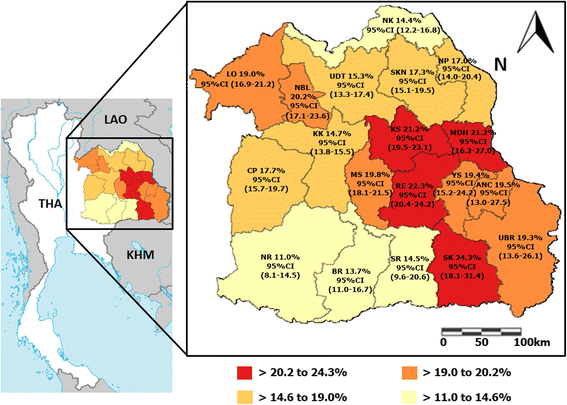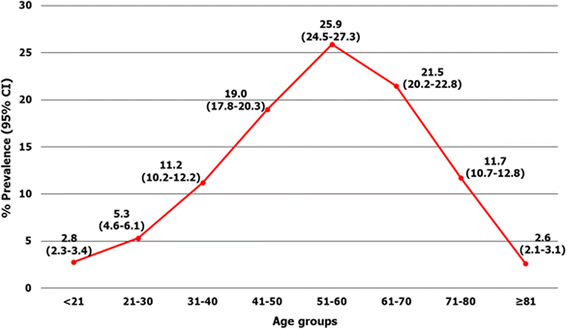An eleven-year retrospective hospital-based study of epidemiological data regarding human strongyloidiasis in northeast Thailand
- PMID: 28923008
- PMCID: PMC5604183
- DOI: 10.1186/s12879-017-2723-z
An eleven-year retrospective hospital-based study of epidemiological data regarding human strongyloidiasis in northeast Thailand
Abstract
Background: Human strongyloidiasis is a chronic and persistent gastrointestinal disease caused by infection with soil-transmitted helminths of the genus Strongyloides. The aim of this research was to obtain diagnostic prevalence regarding strongyloidiasis in northeast Thailand through a hospital-based study.
Methods: Patients' demographic data and the results of stool examinations conducted using the formalin ethyl acetate concentration technique were collected from the parasitology laboratory records at Srinagarind Hospital in Khon Kaen, Thailand. The relevant information from years 2004 to 2014 was collected and descriptively analyzed.
Results: Of a total of 22,338 patients, 3889 (17.4%) had stool samples that tested positive for Strongyloides larvae. The highest prevalence was 22.8% (95% CI = 19.6-26.2%) in the year 2004. This percentage progressively decreased, reaching 11.2% (95% CI = 10.2-12.4%) in 2013 and remaining stable at 12.9% (95% CI = 11.8-14.1%) in 2014. Males (2741 cases) had double the positivity rate of females (1148 cases). The prevalence of infection was highest (25.9%; 95% CI = 24.5-27.3%) among patients that were 51-60 years of age.
Conclusions: Areas endemic for strongyloidiasis should be emphasized under the national helminth control program and health education campaigns. Nationwide assessments should also be performed regarding Strongyloides infection, including risk factors, treatment, and prevention. The diagnostic laboratory data presented here identify the geographical focus of disease to be the northeastern region of the country. Further targeted surveillance using more sensitive methods will almost certainly reveal a higher individual disease burden than found in this report.
Keywords: Hospital-based study; Prevalence; Strongyloidiasis; Thailand.
Conflict of interest statement
Authors’ information
Not applicable.
Ethics approval and consent to participate
Ethical approval without patient informed consent for this de-identified retrospective medical record review was obtained from the Khon Kaen University Ethics Committee for Human Research (HE581354).
Consent for publication
Not applicable.
Competing interests
The authors declare that they have no competing interests.
Publisher’s Note
Springer Nature remains neutral with regard to jurisdictional claims in published maps and institutional affiliations.
Figures


Similar articles
-
Current high prevalences of Strongyloides stercoralis and Opisthorchis viverrini infections in rural communities in northeast Thailand and associated risk factors.BMC Public Health. 2018 Jul 31;18(1):940. doi: 10.1186/s12889-018-5871-1. BMC Public Health. 2018. PMID: 30064407 Free PMC article.
-
Geospatial distribution and risk factors of Strongyloides stercoralis in rural communities of Northeast Thailand.Trop Med Int Health. 2025 May;30(5):393-403. doi: 10.1111/tmi.14100. Epub 2025 Mar 7. Trop Med Int Health. 2025. PMID: 40051313
-
Impact of the health education and preventive equipment package (HEPEP) on prevention of Strongyloides stercoralis infection among rural communities in Northeast Thailand: a cluster randomized controlled trial.BMC Public Health. 2018 Oct 19;18(1):1184. doi: 10.1186/s12889-018-6081-6. BMC Public Health. 2018. PMID: 30340481 Free PMC article. Clinical Trial.
-
Strongyloidiasis with emphasis on human infections and its different clinical forms.Adv Parasitol. 2015 Apr;88:165-241. doi: 10.1016/bs.apar.2015.02.005. Epub 2015 Mar 23. Adv Parasitol. 2015. PMID: 25911368 Review.
-
Strongyloidiasis: a review of the evidence for Australian practitioners.Aust J Rural Health. 2005 Aug;13(4):247-54. doi: 10.1111/j.1440-1584.2005.00710.x. Aust J Rural Health. 2005. PMID: 16048468 Review.
Cited by
-
Prevalence of Opisthorchis viverrini and Its Associated Risk Factors in the Phon Sawan District of Nakhon Phanom Province, Thailand.Iran J Parasitol. 2021 Jul-Sep;16(3):474-482. doi: 10.18502/ijpa.v16i3.7101. Iran J Parasitol. 2021. PMID: 34630593 Free PMC article.
-
Genomic studies on Strongyloides stercoralis in northern and western Thailand.Parasit Vectors. 2020 May 13;13(1):250. doi: 10.1186/s13071-020-04115-0. Parasit Vectors. 2020. PMID: 32404172 Free PMC article.
-
Strongyloides and COVID-19: Challenges and Opportunities for Future Research.Trop Med Infect Dis. 2023 Feb 19;8(2):127. doi: 10.3390/tropicalmed8020127. Trop Med Infect Dis. 2023. PMID: 36828543 Free PMC article. Review.
-
Prevalence of intestinal parasitic infections and genetic differentiation of Strongyloides stercoralis among migrant workers from Myanmar, Lao PDR and Cambodia in northeastern Thailand.PLoS One. 2022 Dec 30;17(12):e0279754. doi: 10.1371/journal.pone.0279754. eCollection 2022. PLoS One. 2022. PMID: 36584196 Free PMC article.
-
Prevalence of Strongyloides in Southeast Asia: a systematic review and meta-analysis with implications for public health and sustainable control strategies.Infect Dis Poverty. 2023 Sep 13;12(1):83. doi: 10.1186/s40249-023-01138-4. Infect Dis Poverty. 2023. PMID: 37705080 Free PMC article.
References
-
- Jongsuksuntigul P, Intapan PM, Wongsaroj T, Nilpan S, Singthong S, Veerakul S, Maleewong W. Prevalence of Strongyloides stercoralis infection in northeastern Thailand (agar plate culture detection) J Med Assoc Thail. 2003;86:737–741. - PubMed
MeSH terms
LinkOut - more resources
Full Text Sources
Other Literature Sources

